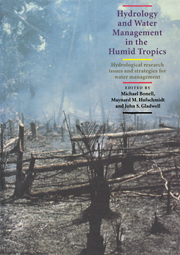 Hydrology and Water Management in the Humid Tropics
Hydrology and Water Management in the Humid Tropics Book contents
- Frontmatter
- Contents
- List of Authors
- Foreword by Federico Mayor, Director-General, UNESCO
- Preface
- Cartographic Credit
- Acknowledgements
- SECTION I INTRODUCTION
- SECTION II HUMID TROPICS SETTING
- SECTION III REGIONAL HYDROLOGY
- SECTION IV PHYSICAL PROCESSES
- 11 Recent Scientific Developments and Research Needs in Hydrological Processes of the Humid Tropics
- 12 Groundwater Systems in the Humid Tropics
- 13 Perspectives on the Hydrology and Water Resource Management of Natural Freshwater Wetlands and Lakes in the Humid Tropics
- 14 Erosion and Sedimentation
- 15 Water Quality Issues in the Humid Tropics
- 16 Ecological Characteristics of Tropical Fresh Waters: An Outline
- SECTION V PHYSICAL PROCESSES – HUMAN USES: THE INTERFACE
- SECTION VI MANAGEMENT ISSUES
- SECTION VII APPENDICES
- Place index
16 - Ecological Characteristics of Tropical Fresh Waters: An Outline
Published online by Cambridge University Press: 23 December 2009
- Frontmatter
- Contents
- List of Authors
- Foreword by Federico Mayor, Director-General, UNESCO
- Preface
- Cartographic Credit
- Acknowledgements
- SECTION I INTRODUCTION
- SECTION II HUMID TROPICS SETTING
- SECTION III REGIONAL HYDROLOGY
- SECTION IV PHYSICAL PROCESSES
- 11 Recent Scientific Developments and Research Needs in Hydrological Processes of the Humid Tropics
- 12 Groundwater Systems in the Humid Tropics
- 13 Perspectives on the Hydrology and Water Resource Management of Natural Freshwater Wetlands and Lakes in the Humid Tropics
- 14 Erosion and Sedimentation
- 15 Water Quality Issues in the Humid Tropics
- 16 Ecological Characteristics of Tropical Fresh Waters: An Outline
- SECTION V PHYSICAL PROCESSES – HUMAN USES: THE INTERFACE
- SECTION VI MANAGEMENT ISSUES
- SECTION VII APPENDICES
- Place index
Summary
ABSTRACT
The characteristics and general ecology of tropical fresh waters are outlined, with reference to the physical and chemical regulation of aquatic environments and the differentiation and dynamics of their communities.
Solar radiation income is the most distinctive and driving variable which leads to relatively high and seasonally-maintained temperatures, with relatively small differentials with depth. This thermally controlled density stratification is sensitive to changes in the energy balance and wind stress, which, in turn, controls chemical and biological stratification. Indefinitely prolonged stratification is common in very deep lakes, and well developed seasonal cycles are frequent, even in equatorial water bodies.
The primary chemical inputs are dominated by rock weathering and atmospheric gaseous exchange, although numerous secondary pathways and controls exist. Dissolved constituents are separable into major, minor and trace elements; gases; and organic compounds. The total ionic content varies widely, but is generally low in the humid tropics. Important interactions between gaseous (CO2) and ionic constituents occur via the CO2/HCO3-/CO32- system, with implications for pH buffering, Ca2+ removal as CaCO3, P removal as apatite, and the biological supply of CO2. Inorganic forms of the nutrient elements N, P and Si are subject to biological depletion; in tropical regions low concentrations of nitrate and high ones of dissolved Si are prevalent. Anoxia is associated with accumulations of the chemically reduced gases CH4, H2S and NH3 with their derivatives, both in very deep and very shallow (swamp) waters. “Black water” rivers carry high concentrations of organic material. The relationship of concentration with river flow rate varies with different chemical constituents, as do upstream-downstream relationships.
- Type
- Chapter
- Information
- Hydrology and Water Management in the Humid TropicsHydrological Research Issues and Strategies for Water Management, pp. 367 - 392Publisher: Cambridge University PressPrint publication year: 1993
- 2
- Cited by


